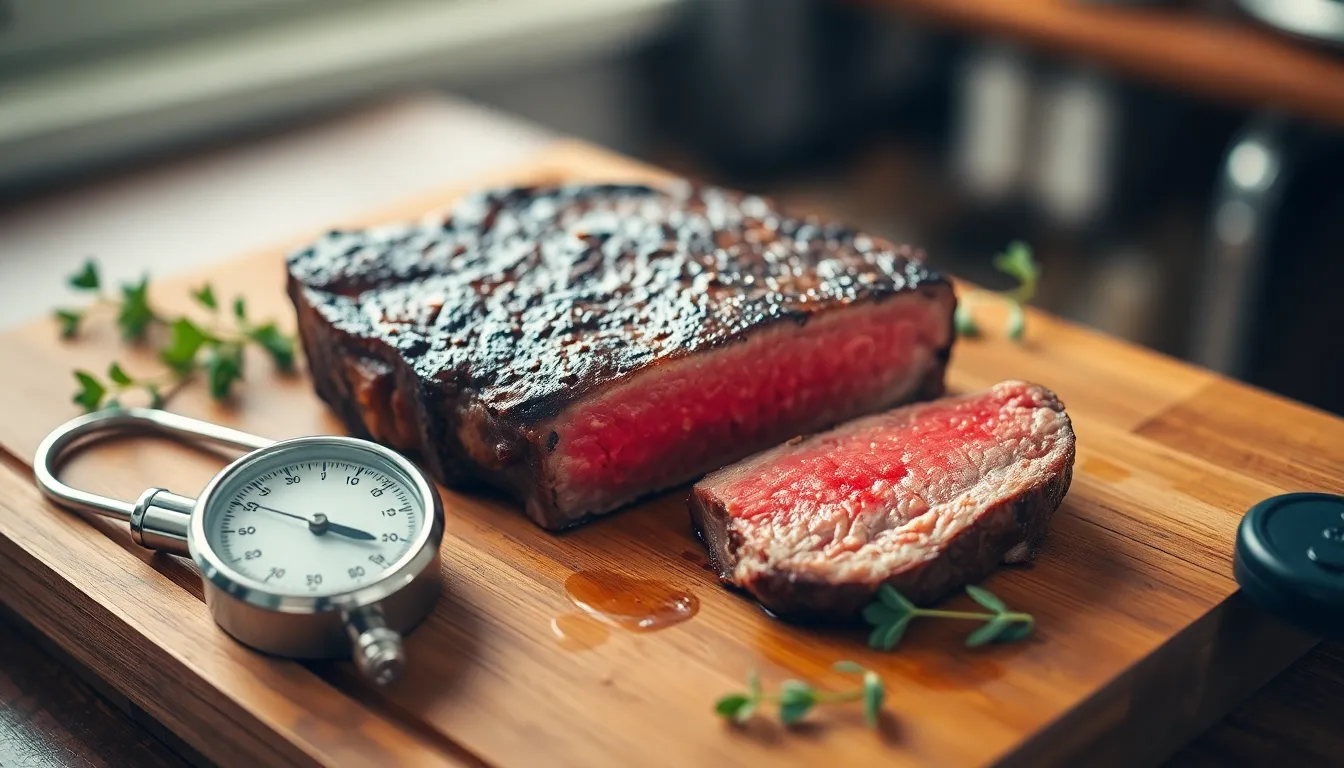Table of Contents
ToggleCooking a medium steak is like mastering a culinary art form that can turn any meal into a masterpiece. But let’s be honest—getting it just right can feel like a high-stakes game of culinary roulette. Too long, and you’ve got a shoe sole on your plate; too short, and it’s practically mooing.
Understanding Steak Cooking Terminology
Understanding essential steak cooking terminology enhances the cooking process and results in a better meal experience. Familiarity with these terms helps anyone navigate the nuances of steak doneness and cuts.
Types of Steak Cuts
Various steak cuts offer distinct flavors and textures. Ribeye boasts marbling that delivers rich taste. Tenderloin provides a lean, buttery bite. T-bone combines tenderloin and strip steak, presenting two textures in one cut. Flank steak supplies a beefy flavor that stands up well to marinades. Sirloin strikes a balance between flavor and tenderness, making it a popular choice.
Cooking Levels Explained
Cooking levels define steak doneness, affecting flavor and texture. Rare steak appears red and cool in the center at about 125°F. Medium-rare offers a warm red center around 130-135°F, often considered the ideal doneness. Medium steak presents a warm pink center at 140-145°F, balancing flavor and tenderness. Medium-well steak has a mostly cooked center, registering at 150-155°F. Well-done steak, cooked to 160°F or higher, contains no pink and can become dry.
Cooking Times for Medium Steak

Cooking a medium steak requires precision to ensure optimal flavor and texture. Understanding the internal temperature and factors affecting cooking time plays an essential role in achieving a perfectly cooked steak.
Recommended Internal Temperature
For medium steak, the recommended internal temperature ranges from 140°F to 145°F. At this temperature, the steak achieves a warm pink center while maintaining juiciness. Using a meat thermometer provides accuracy, eliminating uncertainty. Pull the steak from the heat source just before it reaches 145°F, as it continues cooking slightly after removal. This technique, known as carryover cooking, promotes desired doneness.
Factors Affecting Cooking Time
Cooking time for medium steak varies based on several factors. Thickness of the steak significantly influences duration; thicker cuts require longer cooking times compared to thinner ones. Cooking method also impacts time; grilling, pan-searing, and broiling each create different heat levels. Additionally, steak type matters; a ribeye may cook differently than a sirloin due to fat content and density. Lastly, individual stove or grill heat settings can affect results, so adjusting cooking time based on equipment is crucial.
Cooking Methods for Medium Steak
Various cooking methods can help achieve the perfect medium steak, each with its unique advantages.
Grilling
Grilling provides an excellent way to prepare medium steak, imparting a smoky flavor. Direct heat enhances the Maillard reaction, creating a desirable crust while locking in juices. For perfect results, preheat the grill to medium-high heat, ensuring consistent temperature. Cooking time typically ranges from 6 to 8 minutes per side for a 1-inch thick steak, reaching an internal temperature of 140°F to 145°F. Using a meat thermometer guarantees accurate doneness. Flipping only once prevents moisture loss, resulting in a tender finish.
Pan-Searing
Pan-searing allows for precise control over cooking. A heavy skillet should be heated on medium-high, with oil added to prevent sticking. The steak should be placed in the pan, cooking for about 4 to 5 minutes on each side. After reaching an internal temperature of 140°F to 145°F, resting the steak for a few minutes improves juiciness. Searing creates a caramelized crust while maintaining a tender, pink center. Adding butter or aromatics like garlic can enhance flavors.
Sous Vide
Sous vide offers a meticulous approach, ensuring consistent doneness throughout the steak. Sealing the steak in a vacuum bag allows it to cook in a water bath at a controlled temperature, typically between 140°F and 145°F for medium steak. Cooking times can range from 1 to 4 hours without compromising quality. Finishing the steak with a quick sear in a hot pan adds texture. The sous vide method ensures an evenly cooked steak, eliminating the risk of overcooking, making it a favorite for culinary enthusiasts.
Tips for Perfectly Cooking Medium Steak
Achieving the perfect medium steak requires attention to detail. These practical tips enhance flavor and optimize texture.
Resting Time
Resting time significantly impacts steak juiciness and tenderness. After cooking, allow the steak to rest for 5 to 10 minutes. This practice enables the juices to redistribute throughout the meat. Cutting into the steak too soon can lead to a loss of moisture. Heeding this advice ensures a flavorful and succulent final product.
Seasoning and Marinades
Seasoning and marinades elevate the steak’s flavor profile. Simple seasoning with salt and pepper enhances the meat’s natural taste. For added complexity, consider using garlic, rosemary, or thyme. Marinades can infuse ingredients like soy sauce, olive oil, and vinegar, deepening the flavor. Marinating for at least 30 minutes, or up to overnight, yields richer results. Matching seasonings to the specific steak cut contributes to an unforgettable culinary experience.
Achieving the perfect medium steak is a rewarding challenge that enhances any meal. By understanding the nuances of cooking times and temperatures, anyone can master this culinary skill. The right techniques and methods not only ensure optimal flavor and texture but also elevate the overall dining experience.
With attention to detail and a few simple tips, like resting the steak and using the right seasonings, anyone can create a juicy and tender medium steak that impresses. Whether grilling, pan-searing, or using sous vide, the journey to the ideal steak is well worth the effort.





